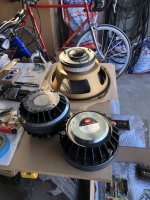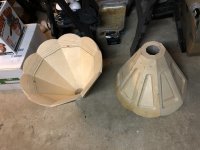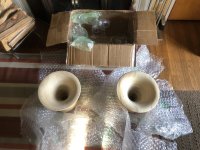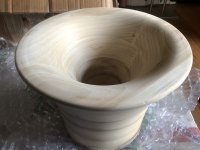Hmmm... I had some of the factory crossovers but don't know where they went. I ended up with active DSP because I use the 4592 for PA. Does sound very nice!
The crossover points on the factory crossover are pretty close and and good place to start, then tweak from there.
The crossover points on the factory crossover are pretty close and and good place to start, then tweak from there.
Im trying to start from pasive as i have good tube amplifier. What crossover point you can recomend as best sounding. Also its for home use and i eant to listen to clasical genre..
That's not easy to get exactly right. BMS recommend 6300 as the crossover point, which is very close. IIRC correctly, I was closer to 6K. You don't have a lot of room either way. And it's going to be somewhat dependent on your horn. My horns, drivers and crossover are 3000 kilometers away at the moment, so checking them will be difficult. 🙂 I will look at the measurements that I did of the 4592 and see if I can figure out a passive crossover to get you started - not definitive at all, but a good start.. Should have it for you within 24 hours.What crossover point you can recomend as best sounding
I’m curious to see what comes of this.
I just came into a used pair of the 4590 I’ve wanted to try for a while along with a second set of horns.
Personally, I’d rather end up with an active system using some of the Bi Amp crossover kits I have stashed…but I have to start somewhere and my second amp for Mids/Highs isn’t finished yet.
I have a MiniDSP to test with, but don’t want to use it as a permanent solution as I find its noise floor is too high with such sensitive drivers.
I have to make a throat adapter for the conical, but I also have a pair of Edgar horns (salad bowls) with 2”throats that should bolt right up. They are supposed to be a Tractrix 330-350Hz profile I believe.
I have a bass system currently set up with an Acoustic Elegance Dipole 15 on a baffle driven by Hypex 502 amps.
I want to move to (4) Acoustic Elegance Dipole 18 I have, but I’m still trying to figure out what type of baffle to put them in and maintain a good height for the horn and BMS.
Just curious…my BMS are labeled 16 Ohm. When I measure the high and low voice coils independently they all measure around 8 Ohms. Is this normal?
I just came into a used pair of the 4590 I’ve wanted to try for a while along with a second set of horns.
Personally, I’d rather end up with an active system using some of the Bi Amp crossover kits I have stashed…but I have to start somewhere and my second amp for Mids/Highs isn’t finished yet.
I have a MiniDSP to test with, but don’t want to use it as a permanent solution as I find its noise floor is too high with such sensitive drivers.
I have to make a throat adapter for the conical, but I also have a pair of Edgar horns (salad bowls) with 2”throats that should bolt right up. They are supposed to be a Tractrix 330-350Hz profile I believe.
I have a bass system currently set up with an Acoustic Elegance Dipole 15 on a baffle driven by Hypex 502 amps.
I want to move to (4) Acoustic Elegance Dipole 18 I have, but I’m still trying to figure out what type of baffle to put them in and maintain a good height for the horn and BMS.
Just curious…my BMS are labeled 16 Ohm. When I measure the high and low voice coils independently they all measure around 8 Ohms. Is this normal?
Attachments
Thst would be nice🙂 thxThat's not easy to get exactly right. BMS recommend 6300 as the crossover point, which is very close. IIRC correctly, I was closer to 6K. You don't have a lot of room either way. And it's going to be somewhat dependent on your horn. My horns, drivers and crossover are 3000 kilometers away at the moment, so checking them will be difficult. 🙂 I will look at the measurements that I did of the 4592 and see if I can figure out a passive crossover to get you started - not definitive at all, but a good start.. Should have it for you within 24 hours.
OK, here is a crossover that should get you started and at least playing music. Don't spend a lot of money on parts, just get normal quality, like Solen Jantzen, etc. At this point getting the crossover values correct will have far more influence than the quality of the parts. This is an easy build.
You will L-Pad to attenuate the horn (shown as R3/R4) down to your woofer level. I suggest using one anyway even if you have a separate amp for the BMS because it will help raise your S/N ratio. In this case DO spend some money on the L-Pad, as the cheap ones don't work well. When it's all dialed in, you can replace the L-Pad with high quality resistors.
This schematic shows the tweeter section in reverse polarity. That works best from the published specs, but in my measurements the tweeter in the same polarity summed better.
You can adjust or bypass R1 if you need to change the level of the highs above 6 kHz.
This crossover is something that should work well, but it is NOT optimized. For that you will need to measure both the acoustic response of your horn, as well as the driver impedance and do a good bit more work. The software and help are free, the measurement hardware will cost you a few hundred dollars. These BMS coaxials are very clean, very good drivers. It's worth the time and effort to get the crossover right.

You will L-Pad to attenuate the horn (shown as R3/R4) down to your woofer level. I suggest using one anyway even if you have a separate amp for the BMS because it will help raise your S/N ratio. In this case DO spend some money on the L-Pad, as the cheap ones don't work well. When it's all dialed in, you can replace the L-Pad with high quality resistors.
This schematic shows the tweeter section in reverse polarity. That works best from the published specs, but in my measurements the tweeter in the same polarity summed better.
You can adjust or bypass R1 if you need to change the level of the highs above 6 kHz.
This crossover is something that should work well, but it is NOT optimized. For that you will need to measure both the acoustic response of your horn, as well as the driver impedance and do a good bit more work. The software and help are free, the measurement hardware will cost you a few hundred dollars. These BMS coaxials are very clean, very good drivers. It's worth the time and effort to get the crossover right.
Are you running the MiniDSP at too low a level? Some people do that because the horns are so sensitive, but you should drive the DSP fairly hot and attenuate afterward.I have a MiniDSP to test with, but don’t want to use it as a permanent solution as I find its noise floor is too high with such sensitive drivers.
Yes, that's about were my BMS4592 drivers measure. DCR near 8 ohms for the 16 ohm model.When I measure the high and low voice coils independently they all measure around 8 Ohms. Is this normal?
Hi Pano
I was initially running the MiniDSP on an older laptop supply that didn’t seem bad…I’m guessing that was at about 20V, give or take.
I can’t remember what drivers I was testing at the time.
That supply died on me and I tried replacing it with another 19V laptop supply I got from Radioshack.
The new supply was horrible in comparison. Between tracks a prominent hissing was driving me nuts. I think I had moved to some more sensitive Lowthers in front horns at the time.
After that I even tried a 24 V NiCad battery supply, but I don’t remember the noise level improving.
These are not MiniDSP HD boards. They were early standard 2X4 boards I bought used and assembled into a case myself.
I’m wondering if I have the gain set at too high a level in them without realizing it. I did wire in an attenuator to the boards that I believe I used to leave set at about 50%.
Haven’t used them in a while…I’ll have to give it another go.
Either way, I still want to build my Bi Amp crossover kits based on whatever I come up with experimenting with the MiniDSP.
I was initially running the MiniDSP on an older laptop supply that didn’t seem bad…I’m guessing that was at about 20V, give or take.
I can’t remember what drivers I was testing at the time.
That supply died on me and I tried replacing it with another 19V laptop supply I got from Radioshack.
The new supply was horrible in comparison. Between tracks a prominent hissing was driving me nuts. I think I had moved to some more sensitive Lowthers in front horns at the time.
After that I even tried a 24 V NiCad battery supply, but I don’t remember the noise level improving.
These are not MiniDSP HD boards. They were early standard 2X4 boards I bought used and assembled into a case myself.
I’m wondering if I have the gain set at too high a level in them without realizing it. I did wire in an attenuator to the boards that I believe I used to leave set at about 50%.
Haven’t used them in a while…I’ll have to give it another go.
Either way, I still want to build my Bi Amp crossover kits based on whatever I come up with experimenting with the MiniDSP.
Looks like that crossover estimate wasn't well received. No comments or questions from Lowerideris?
just a curiosity does it work on 4592nd?OK, here is a crossover that should get you started and at least playing music. .......
It should for 8 ohm. I used the measurements of my 4692 as a double check. It won't be exact, but it should be a good start. You'll need to measure and tweak to dial it in.
sorry for hijacking the thread.It should for 8 ohm. I used the measurements of my 4692 as a double check. It won't be exact, but it should be a good start. You'll need to measure and tweak to dial it in.
Mine read 16ohms on the label
OK, mine are also 16 ohm, but I could not find any impedance measurements that I have run. I'll see what the published impedance looks like.
Sorry if I missed it, but was this crossover designed for 16 ohm drivers?OK, mine are also 16 ohm, but I could not find any impedance measurements that I have run. I'll see what the published impedance looks like.
Also would it hurt to use a passive on the coax driver and an active between the bass horn and the coax?
I don’t remember if the passive crossover was for 16 ohms. I would hope so! 🙂
Yes it’s OK to mix active and passive.
Yes it’s OK to mix active and passive.
Can an autoformer work to meet 12P80Ndv2 at 99db somewhere at about 800hz?OK, here is a crossover that should get you started and at least playing music. Don't spend a lot of money on parts, just get normal quality, like Solen Jantzen, etc. At this point getting the crossover values correct will have far more influence than the quality of the parts. This is an easy build.
You will L-Pad to attenuate the horn (shown as R3/R4) down to your woofer level. I suggest using one anyway even if you have a separate amp for the BMS because it will help raise your S/N ratio. In this case DO spend some money on the L-Pad, as the cheap ones don't work well. When it's all dialed in, you can replace the L-Pad with high quality resistors.
This schematic shows the tweeter section in reverse polarity. That works best from the published specs, but in my measurements the tweeter in the same polarity summed better.
You can adjust or bypass R1 if you need to change the level of the highs above 6 kHz.
This crossover is something that should work well, but it is NOT optimized. For that you will need to measure both the acoustic response of your horn, as well as the driver impedance and do a good bit more work. The software and help are free, the measurement hardware will cost you a few hundred dollars. These BMS coaxials are very clean, very good drivers. It's worth the time and effort to get the crossover right.
View attachment 1052748
If you have measurements or specs that you trust, perhaps test this:
//
XMachina is a passive crossover designer.
XMachina works unassisted. Define your goals, import drivers characteristics start XMachina and let it create designs for you.
There are several goals that XMachina tries to achieve:
- use only "real" component values (specified on lists),
- get close to the target dBspl system response,
- do not go under specified system impedance limit,
- do not exceed electro-acoustical slopes defined for ways,
- do not use many components unless it's necessarily.
XMachina works in any Win32-compatibile environment.
It has been tested on Win10/64...
XMachina works unassisted. Define your goals, import drivers characteristics start XMachina and let it create designs for you.
There are several goals that XMachina tries to achieve:
- use only "real" component values (specified on lists),
- get close to the target dBspl system response,
- do not go under specified system impedance limit,
- do not exceed electro-acoustical slopes defined for ways,
- do not use many components unless it's necessarily.
XMachina works in any Win32-compatibile environment.
It has been tested on Win10/64...
- XMechanik
- Replies: 316
- Forum: Software Tools
//
YesUse an autoformer to adjust the tweeter level?
- Home
- Loudspeakers
- Multi-Way
- Crossover for BMS 4590 driver



